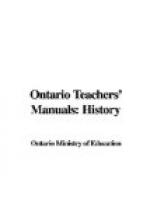This is added to the outline, and the whole story is reproduced orally before the class is dismissed.
As desk work, the outline is copied in note-books and the pupils are directed to read the full story in Parkman’s Montcalm and Wolfe, or in the History Reader, pp. 284-292.
NOTE: If plasticine be used, miniature cannon, ships, bridges, etc., may be placed in position and a realistic explanation of the battle given. This would require more time and the whole story would require several lesson spaces.
References: The
text-book, Weaver’s Canadian History for Boys
and
Girls, and Parkman’s
Montcalm and Wolfe.
FORM III
THE COMING OF THE UNITED EMPIRE LOYALISTS
1. Narrate briefly the story of the American Revolution, to show why they had to leave the country; describe the treatment given to them by the revolutionists; how they lost their property; how they were driven from their homes and exposed to all sorts of hardships, sometimes fatal to the women and children; emphasize their constant feeling of loyalty in face of all their troubles.
2. There was nothing for them to do but go to some place where the British flag still flew. The pupils may be asked, with the map before them, to consider where they would be most likely to go. What were the probable routes they would follow? That would depend on where they lived in the States. What methods of travel could they use? The class will see from a consideration of these points how they did travel, what routes they followed, and where they settled down. The waterways would have to be emphasized and traced out on the map; by sea from New York and Boston to Nova Scotia; by Lake Champlain and the Richelieu River to Quebec and Eastern Ontario; by the western rivers, the Mohawk, the Genesee, etc., to Western Ontario. (See Fourth Reader, p. 170.)
3. What the Government did for them and how they succeeded. Any account of life in Canada in the early days will give the necessary information. It may be that some old settler of the neighbourhood can supply the story to one of the children.
4. In the Senior Form there may be taken up slightly the political ideals of these Loyalists and how their presence led to changes in affairs in Upper Canada.
FORM III
THE FLAG
In itself a flag is “only a small bit of bunting”; it becomes a powerful aid to patriotism when it receives a meaning from its history. It is the emblem of a nation, the symbol of sovereignty, and as such should have a prominent place in the education of the young. Children should be taught: (1) the history of the struggles and sacrifices of our forefathers in securing and maintaining our liberties; (2) the significance of the flag as standing for liberty, truth, and justice; and (3) its construction, with the special significance of each part.




